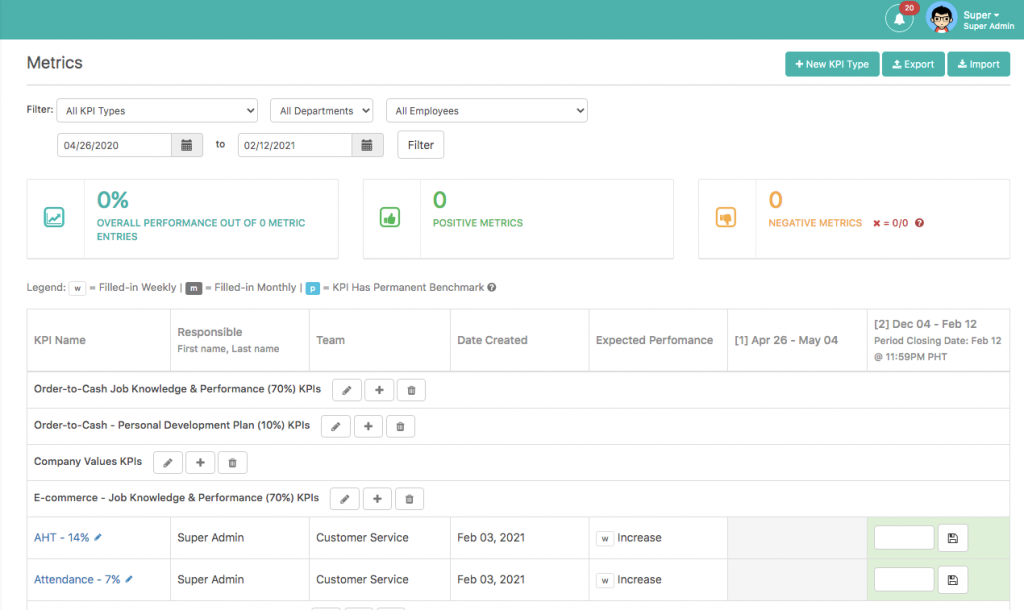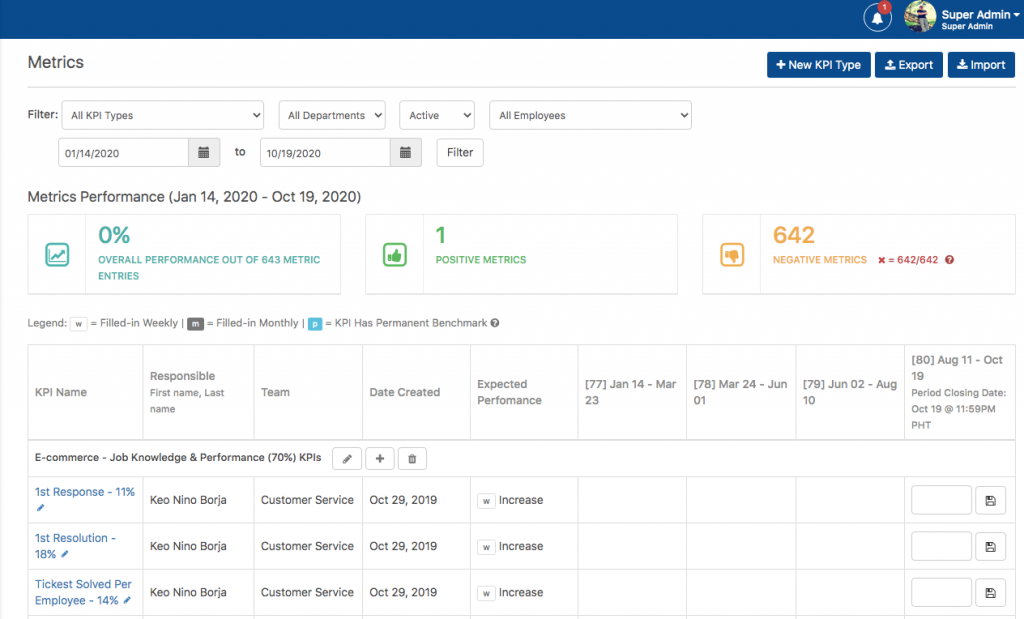Access Level: SuperAdmin, Admin, Supervisor, Employee
Metrics page displays the Company’s Performance Metrics in a 4-week preview consisting of positive, negative, and overall performance. This is where super admin and admin can add, edit and disable KPI metrics, assign KPIs to any number of employees, track KPI history, and import and export KPI Metrics data.

Supervisors and Employees ONLY have the viewing capability of the KPI metrics assigned to them.

Metrics Features
- Dynamic Filter
– Dynamic filter is available for easier viewing. User can filter using KPI types, Department, Status, Employees and calendar filter.
Access Level: SuperAdmin, Admin, Supervisor, Employee

- + New KPI Type
– To add a new KPI type, click the “+Add New KPI Type” button. It opens a new window where the KPI Type Name and Department fields are required.
– When no Department is available, the Super admin should create a new department first under Settings Menu prior to successfully creating a new KPI.
Access Level: SuperAdmin, Admin


**When a department is deleted, the existing KPIs attached to it also get deleted.
- Edit KPI Type
– Beside the KPI type name, there’s the edit icon in where user can edit the KPI type name and the selected Department.
Access Level: SuperAdmin, Admin

- Delete KPI Type
– Deleting a KPI Type will delete all the KPIs created under it and can’t be reverted.
Access Level: SuperAdmin ONLY

- Add New KPI under a KPI Type
– + button is available under a KPI Type to add a KPI for specific employees under the selected department of the KPI type.
Access Level: SuperAdmin, Admin

KPI Name: this is a required field. Any value can be used in this field.
Assign To: This is a dropdown list of all employees under the selected department of the KPI Type.
Have Default BenchMark? : It’s a yes or no field where the default KPI benchmark can be defined. If Yes is selected, a BenchMark field will show.
Unit of Measurement: This is an optional field. The unit of measurement for a KPI can be express in seconds (s), percentage (%), currency ($) and etc.
Type of Measurement: Can choose between increase or decrease value.
Fill-in Schedule: Value can be monthly or weekly
Team or Project: This is an optional field
- Edit KPI under a KPI Type
– Clicking on the KPI names opens a dialog window where the user can edit the existing data of the KPI.
Access Level: SuperAdmin, Admin
- View Metric History
– Clicking the KPI name opens a dialog box, at the bottom part of the dialog, shows a hyperlink to View Metric History. Clicking the link opens a new tab where all KPI metrics history is displayed.
Access Level: SuperAdmin, Admin

- Disable KPI
– Disabled KPI Metric will show under “Inactive” Filter. To disable a metric, simply click the KPI name and scroll down at the bottom of the dialog box where “disable” link is available.
Access Level: SuperAdmin, Admin

- Input KPI Metric Value
– Super Admin and Admin can input the metric value of the KPI in the column of the specified fill-in schedule
– The KPI schedule creates a new row automatically within 15 minutes after the previous KPI metrics schedule is done. Can be weekly or monthly. - The KPI Metrics schedule is dependent on the server time which follows the GMT+8 Asia/Hongkong timezone.
- The thumb icons, whether it’s up/down is being based and generated after the first 3 KPI Metrics score.
Access Level: SuperAdmin, Admin

- Export Metrics
– Super admin and admin can export one or more KPI metrics by clicking the “Export” button on the upper-right of the Metrics page.
– Metrics to be exported can be filtered by KPI types, status, employee name, and calendar date range.
Access Level: SuperAdmin, Admin,


- Import KPI Metrics
User Level Access: SuperAdmin and Admin

To import KPI Metrics, you should download the provided template that can be found in the “Metrics” page > Import button > Download the template here.
The KPI Metrics import pop-up windows shows the instructions on how to import metrics, and must be followed to successfully do so.
Important Notes: Only importing new KPI is supported. Updating of KPI’s are out of scope yet. If existing KPI is imported, the system will skip the process and proceed to the next item in the CSV file.
KPI type ID and KPI Type should also be pre-existing when uploading a KPI. Uploading a new KPI Type ID and KPI Type will display an error.
All cells are required to be filled except for the “KPI ID” and the “Period (number)”.
KPI Type ID: This is an auto-generated number when you export the existing KPI and or download the CSV format. This shouldn’t be edited.
KPI Type: KPI Type should also be existing in the system. Editing this field or entering a new KPI type is still out of scope.
KPI ID: KPI ID can be left as blank, the system will auto-generate the KPI ID once the file is imported.
KPI Name: KPI name should be new and unique. Since the system does not support updating yet, when the entered KPI name already exists, the system will skip the item in the file.
Employee Email: This should contain the email address of the user identified under the responsible column. It should be pre-existing in the system.
Responsible: Employee name should be existing and correctly entered.
Team: You can either identify your team here or leave it as blank
Expected Performance: Should identify whether the performance is positive (w) increase or negative (w) decrease.
Period [number]: this is not a required field – you can either leave it as blank or enter a value.
Once all fields are already filled correctly, upload the CSV file and click import to successfully import new KPIs.
Understanding Metrics Rules
User Access Levels: Super admin and admin
In every created KPI Type, there should be a corresponding department assigned. This means that this KPI can be applied to everyone that is under on the selected department.
Super Admin and/or admin can create multiple KPIs under a created KPI Type. Each KPIs can have multiple Periods or also known as schedules, which contains the KPI Metrics scores.
Setting a Permanent Benchmark on the create KPI means the KPI metrics scores is fixed. The metric score is automatically computed on the backend after 3 completed schedules/period.

